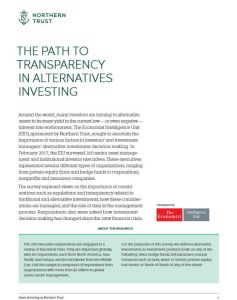Join getAbstract to access the summary!

Join getAbstract to access the summary!
The Economist Intelligence Unit
The Path to Transparency in Alternatives Investing
EIU, 2017
What's inside?
As alternative investments become more popular, transparency becomes even more essential.
Recommendation
The popularity of alternative assets has mushroomed since 2005 and remained strong even after the 2008 financial crisis. Since then, investing in alternatives such as real estate, hedge funds and private equity has become more mainstream. Yet the rapid growth of these often-opaque assets has given rise to investor concerns about risk, and investment firms are dealing with the challenges of providing transparency. This Economist Intelligence Unit global survey of 200 asset managers offers useful guidelines for overcoming the information obstacles these nontraditional products pose. getAbstract recommends this behind-the-scenes report to financial professionals and investors.
Summary
About the Author
The Economist Intelligence Unit is an independent research and analysis organization.



















Comment on this summary